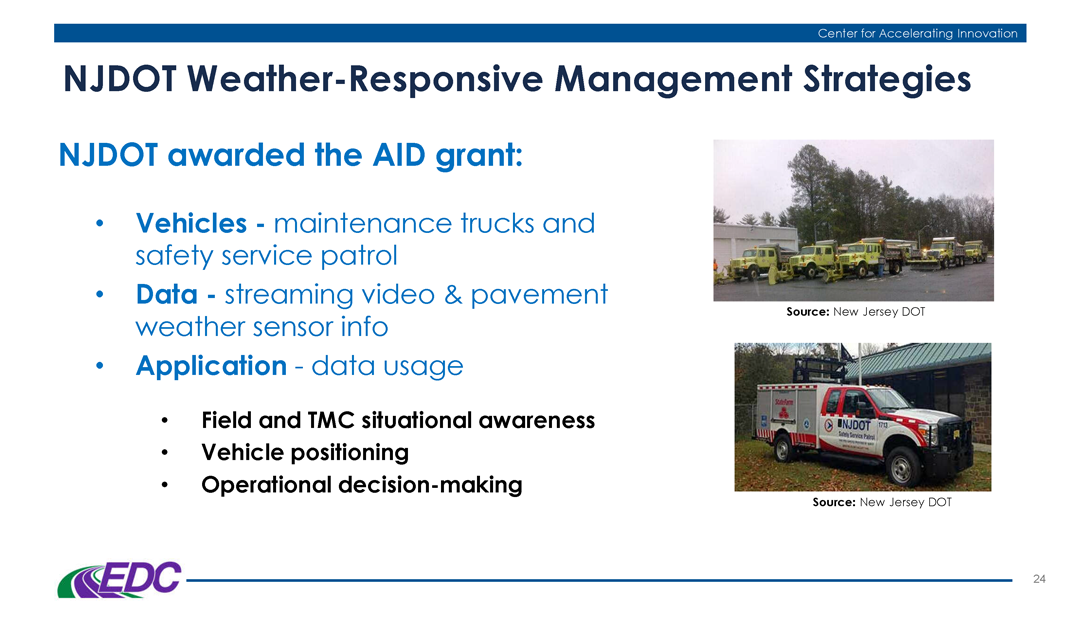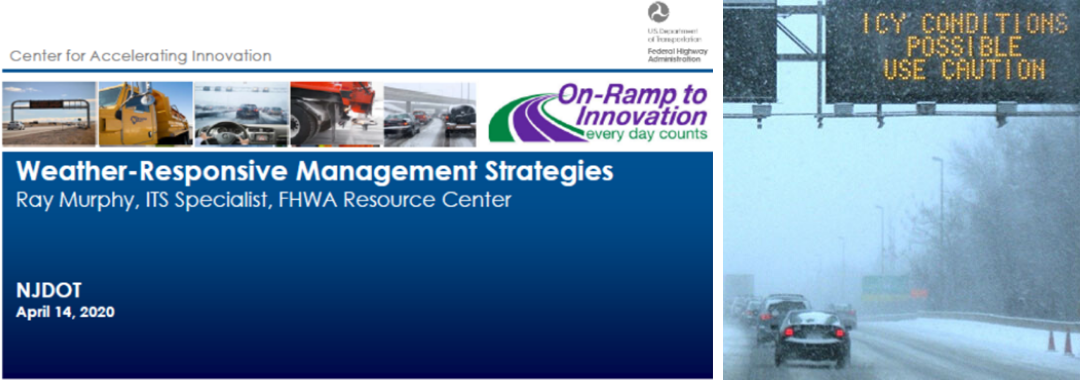On April 14, 2020, the NJDOT Bureau of Research hosted a Lunchtime Tech Talk! webinar on "EDC-5 Weather-Responsive Management Strategies." This event featured a presentation by Ray Murphy, ITS Specialist with the FHWA's Resource Center. Under Round 5 of the Every Day Counts (EDC) program, FHWA promotes Weather-Responsive Management Strategies (WRMS) to manage traffic and road maintenance during inclement weather to improve safety and reliability, and minimize environmental impacts associated with weather events. Weather affects: traffic safety, with 21 percent of the nearly 6 million roadway crashes in the past decade related to weather; mobility, resulting in reduced efficiency and productivity; and environmental impacts on watersheds, air quality, and infrastructure.

Mr. Murphy provided examples of weather responsive practices being tried by state DOTs, including an advanced traveler information notification deployed by Iowa DOT.
Mr. Murphy described the prior-round, EDC-4 innovation, Road Weather Management – Weather-Savvy Roads, that formed the basis for this EDC-5 initiative. The innovation promoted data collection including Pathfinder, a collaboration between the National Weather Service, state DOTs, and state support contractors to provide weather information and forecasts, and Integrating Mobile Observations (IMO) that collects weather and road condition data from instruments on agency fleet trucks.
Through WRMS, FHWA promotes the use of mobile data to support decision making. Benefits to agencies include improved safety, system performance and operations, and reduced costs and environmental impacts. Agencies can use Weather Responsive Management Systems to address diverse internal needs such as staffing, material use, and route optimization, and condition and performance reporting. Data sources include transportation agency fleets, private vehicles, third party entities, agency operators, road users and infrastructure. Some data is collected by in-vehicle sensors, video and camera images, and automatic vehicle location. Other data sources include fixed Roadway Information System (RWIS), National Weather Service, reports from road users and operators, mobile observations and connected vehicle data, among others.
The traveling public benefits through safer pre-trip and real-time route decision making based on enhanced traveler information, roadside messaging, variable speed limits, and road lane closures or restrictions. Unified, localized, and more accurate messaging gives the public increased confidence in the messaging and the agency.
Mr. Murphy addressed some common challenges that agencies face in adopting this innovation, such as a lack of connectivity in remote areas, the need for buy-in from agency leadership and from road crews, hesitance to adopt the innovation, and funding.

Mr. Murphy highlighted recent initiatives undertaken by NJDOT related to Weather Responsive Management Strategies that have been funded in part through FHWA innovation grants.
He noted that the State Transportation Innovation Council (STIC) Incentive Program and STIC Accelerated Innovation Deployment (AID) grants can help fund implementation of these technologies. NJDOT received a STIC incentive funding grant to support pilot testing of technology used by the Safety Service Patrols. NJDOT was also awarded an AID Grant from FHWA to support a weather savvy roads pilot program, installing video camera dashboards and sensors onto NJDOT maintenance trucks and safety service patrol vehicles to collect streaming video and weather / pavement information to support road weather management throughout the state.
Webinar participants had an opportunity to pose questions of Mr. Murphy. One participant asked about possible resistance to installation of automatic vehicle locators due to privacy concerns. Mr. Murphy noted that agencies must operate openly and inclusively when implementing this technology. Training and education can help users become more accepting of the technology.
A participant asked about the use of IMO data versus information gathered from a public entity such as WAZE. Mr. Murphy responded that the agency receives the IMO data directly and can oversee the accuracy of the data, but that information should come from multiple sources to create a robust dataset.
When asked what agencies consider the biggest challenges, and what arguments can be used to support this innovation, Mr. Murphy responded that funding is always a concern but that buy-in is often the larger issue. He emphasized the need for a champion who can demonstrate the benefits of the strategies through performance measures.
When asked if specific applications of WRMS were being considered for EDC-6, Mr. Murphy responded that various innovative practices were being considered and no decisions had been made yet.
A participant asked if these systems can be adapted to rockfall data. Mr. Murphy noted that visibility apps used with dust storms or fire events could be adapted for other weather events.
Mr. Murphy’s presentation offered several examples of DOTs nationwide employing these strategies. A participant asked if any states are quantifying the benefits of WRMS implementation. Mr. Murphy offered that Caltrans is one agency.
The presentation given by Mr. Murphy can be downloaded here.
More information on this innovation is available on the FHWA Weather Responsive Management Systems resources page.
A recording of the webinar is available here, (also to the right).

